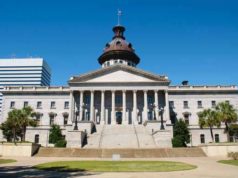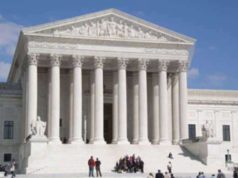Table of Contents

The United States Supreme Court is the highest court in the country, tasked with adjudicating on some of the most significant legal issues in the nation. The court has nine members, including a Chief Justice who leads the court and eight Associate Justices. Each justice is appointed for life by the President of the United States with the advice and consent of the Senate. This article will explore the current membership of the Supreme Court, including the justices’ backgrounds, their ideology, and their judicial philosophy.
Chief Justice John Roberts
John Roberts was born in 1955 in Buffalo, New York. After working as a lawyer for several years, he served in the Department of Justice under President Ronald Reagan and was later appointed to the United States Court of Appeals for the District of Columbia Circuit. President George W. Bush nominated Roberts to be Chief Justice of the United States in 2005, and he was confirmed by the Senate later that year.
Roberts is widely considered to be a conservative on the Supreme Court. He has been a consistent vote against affirmative action and has generally taken a narrow view of the scope of federal power. However, Roberts has also shown himself to be willing to depart from orthodox conservative positions on occasions. For example, he cast the deciding vote to uphold the Affordable Care Act in 2012, surprising many conservatives who had expected him to Vote against the law. Roberts is known for his strict adherence to legal precedent, and he emphasizes the importance of judicial independence and the rule of law.
Justice Clarence Thomas
Clarence Thomas was born in 1948 in Pin Point, Georgia. After working in private practice for several years, he served in a variety of government positions, including assistant attorney general and chairman of the Equal Employment Opportunity Commission. In 1991, President George H.W. Bush nominated Thomas to the Supreme Court, and he was confirmed by the Senate after a contentious confirmation battle.
Thomas is known for his conservative views on the Supreme Court. He is an originalist who believes that the Constitution should be interpreted based on its original meaning, and he has been highly critical of Roe v. Wade, the landmark decision that legalized abortion nationwide. Thomas is also known for his opposition to affirmative action and his skepticism of federal power. He often takes a narrow view of the Commerce Clause, which gives Congress power to regulate commerce among the states.
Justice Stephen Breyer
Stephen Breyer was born in 1938 in San Francisco, California. After working as a lawyer and serving as a judge on the United States Court of Appeals for the First Circuit, he was appointed to the Supreme Court by President Bill Clinton in 1994.
Breyer is generally considered to be a pragmatic liberal on the Supreme Court. He is known for his emphasis on the practical consequences of legal rulings, and he often takes a more flexible approach to legal interpretation than some of his more ideologically rigid colleagues. Breyer is a strong advocate for individual rights and civil liberties, and he has been a vocal defender of the rights of criminal defendants. He is also an advocate for international law and often cites foreign legal precedents in his opinions.
Justice Samuel Alito
Samuel Alito was born in 1950 in Trenton, New Jersey. After working as a lawyer and serving as a federal prosecutor, he was appointed to the United States Court of Appeals for the Third Circuit in 1990. In 2006, President George W. Bush nominated Alito to the Supreme Court, and he was confirmed by the Senate later that year.
Alito is generally considered to be a conservative on the Supreme Court. He is known for his strong interest in issues of federalism and the separation of powers, and he has been a consistent vote against affirmative action and other forms of race-based policies. Alito is also a strong advocate for individual rights, and he has written several influential opinions on the First Amendment and other civil liberties issues.
Justice Sonia Sotomayor
Sonia Sotomayor was born in 1954 in New York City, the daughter of Puerto Rican immigrants. She served as a lawyer before being appointed to the United States District Court for the Southern District of New York and later the United States Court of Appeals for the Second Circuit. In 2009, President Barack Obama nominated Sotomayor to the Supreme Court, and she was confirmed by the Senate later that year.
Sotomayor is generally considered to be a liberal on the Supreme Court. She is known for her strong interest in issues of social justice and her advocacy for the rights of minority groups and marginalized communities. Sotomayor has been a consistent vote in favor of affirmative action and other race-conscious policies, and she has also been a vocal defender of the rights of criminal defendants.
Justice Elena Kagan
Elena Kagan was born in 1960 in New York City. After working as a lawyer and serving as a senior official in the Clinton administration, she was appointed dean of Harvard Law School in 2003. President Barack Obama nominated Kagan to the Supreme Court in 2010, and she was confirmed by the Senate later that year.
Kagan is generally considered to be a liberal on the Supreme Court. She is known for her strong academic background and her interest in legal theory and philosophy. Kagan is also an advocate for the rights of women and other marginalized groups, and she has written several influential opinions on issues such as the First Amendment and campaign finance reform.
Justice Neil Gorsuch
Neil Gorsuch was born in 1967 in Denver, Colorado. After working as a lawyer and serving as a judge on the United States Court of Appeals for the Tenth Circuit, he was nominated to the Supreme Court by President Donald Trump in 2017.
Gorsuch is generally considered to be a conservative on the Supreme Court. He is known for his strong interest in issues of federalism and the separation of powers, and he has been a consistent vote against federal agency action and executive authority. Gorsuch is also an originalist who believes in a strict interpretation of the Constitution, and he has been a critic of the Supreme Court’s expansive interpretation of individual rights and other constitutional doctrines.
Justice Brett Kavanaugh
Brett Kavanaugh was born in 1965 in Washington, D.C. After working as a lawyer and serving as a judge on the United States Court of Appeals for the District of Columbia Circuit, he was nominated to the Supreme Court by President Donald Trump in 2018 after a highly controversial confirmation process.
Kavanaugh is generally considered to be a conservative on the Supreme Court. He is known for his strong interest in issues of judicial restraint and statutory interpretation, and he has been a critic of judicial activism and the expansion of executive power. Kavanaugh is also an originalist who believes in a strict interpretation of the Constitution, and he has been a strong advocate for gun rights and other conservative issues during his time on the Court.
Conclusion
The current membership of the Supreme Court is a diverse group with a range of different backgrounds, ideologies, and judicial philosophies. While some members of the Court are known for their strict adherence to legal precedent and originalism, others take a more pragmatic or flexible approach to legal interpretation. These different perspectives can influence the Court’s decisions on important legal issues, and they reflect the complexity and diversity of American law and jurisprudence.
In the discussions that have been held of the various Supreme Courts found throughout American history, one of the most pressing questions has been the current membership of those bodies.
Supreme Courts are grouped in historical terms by the identity and duration of the term of their various Chief Justices, but the backgrounds and philosophies of the individual Associate Supreme Court Justices has also exercised a decisive impact on American history.
At present, the Supreme Court is being administered by Chief Justice John G. Roberts. One important aspect of Supreme Courts is their political orientation, toward which end the current court is considered more conservative than liberal, both due to Roberts’ views and the judicial leanings of a majority of the individual Supreme Court Justices. Roberts has been the Chief Justice since 2005 when he was nominated by the George W. Bush administration and approved by Congress to replace the previously sitting Chief Justice, William Rehnquist(1986-2005). In view of the recent start of his term, the Roberts can be assumed to likely be in place for some time.
The individual terms of Supreme Court Justices are not decided by the informal determination of Supreme Court “eras”, and are not unlikely to last through two Supreme Courts. In regard to the Supreme Courts during which the sitting Supreme Court Justices began their service, most of the members now on the bench began during Rehnquist’s term. They include: Antonin Scalia (appointed in 1986), Anthony Kennedy (1988), Clarence Thomas (1991), Ruth Bader Ginsberg (1993), and Stephen Breyer (1994). The Roberts court has thus far seen two appointments: Samuel Alito in 2006 by the Bush White House, and Sonia Sotomayor in 2009 by Barack Obama.
The longest term of any of the currently sitting Supreme Court Justices is that of John Paul Stevens, who began in 1975 by appointment by President Gerald Ford under the Burger court (1969-1986). In addition to Roberts, the identification of the current membership as conservative in comparison to previous Supreme Courtsrests on the consensus on Justices Scalia, Thomas, and Alito.
In contrast to these Supreme Court Justices, Ginsburg, Breyer, and Stevens have long been identified with liberalism, while Sontamayor is generally thought of as a liberal, though more in regard to past legal decisions and public statements than any the comprehensive pattern thus ascertained on the bench. The political identification of Justices, and thus, of Supreme Courts can differ in practice from what might have been assumed by nominating presidents, in which regard Justice Kennedy has been identified as conservative in nature but sometimes inclined toward political decisions.
The recently announced retirement of Justice Stevens has raised a similar issue among commentators in regard to President Obama’s proposed replacement of legal scholar Elena Kagan. Kagan has been identified in a broad sense with the Democratic, liberal consensus. Her past decisions have also revealed a conservative streak. If approved, Kagan,currently the United States Solicitor General, would be the only member who has not previously been a judge.



















